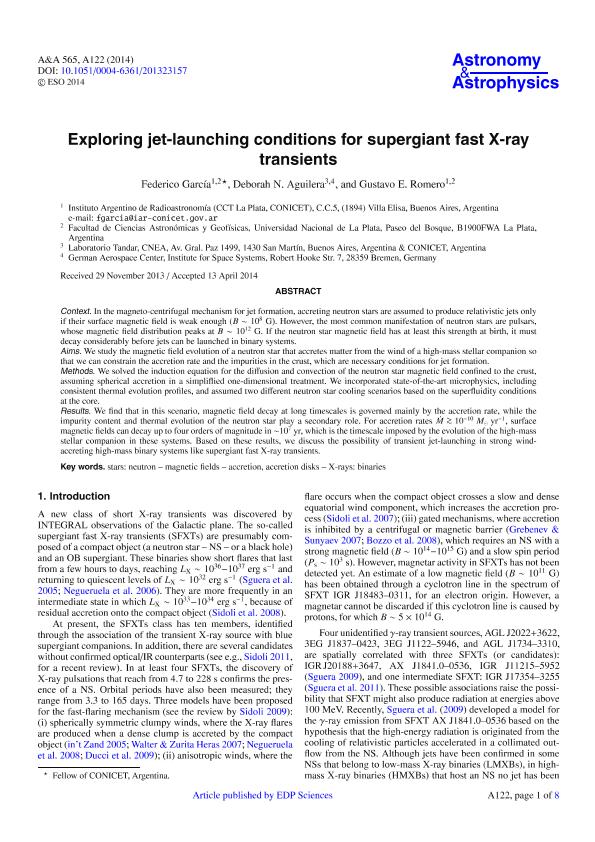Mostrar el registro sencillo del ítem
dc.contributor.author
García, Federico

dc.contributor.author
Romero, Gustavo Esteban

dc.contributor.author
Aguilera, Deborah Nancy

dc.date.available
2016-04-18T20:48:40Z
dc.date.issued
2014-05-22
dc.identifier.citation
García, Federico; Romero, Gustavo Esteban; Aguilera, Deborah Nancy; Exploring jet-launching conditions for supergiant fast X-ray transients; EDP Sciences; Astronomy and Astrophysics; 565; A122; 22-5-2014; 1-8
dc.identifier.issn
0004-6361
dc.identifier.uri
http://hdl.handle.net/11336/5261
dc.description.abstract
Context. In the magneto-centrifugal mechanism for jet formation, accreting neutron stars are assumed to produce relativistic jets only if their surface magnetic field is weak enough (B ∼ 10^8 G). However, the most common manifestation of neutron stars are pulsars, whose magnetic field distribution peaks at B ∼ 10^12 G. If the neutron star magnetic field has at least this strength at birth, it must decay considerably before jets can be launched in binary systems. Aims. We study the magnetic field evolution of a neutron star that accretes matter from the wind of a high-mass stellar companion so that we can constrain the accretion rate and the impurities in the crust, which are necessary conditions for jet formation. Methods. We solved the induction equation for the diffusion and convection of the neutron star magnetic field confined to the crust, assuming spherical accretion in a simpliflied one-dimensional treatment. We incorporated state-of-the-art microphysics, including consistent thermal evolution profiles, and assumed two different neutron star cooling scenarios based on the superfluidity conditions at the core. Results. We find that in this scenario, magnetic field decay at long timescales is governed mainly by the accretion rate, while the impurity content and thermal evolution of the neutron star play a secondary role. For accretion rates M ~ 10−10 M⊙ yr^−1, surface magnetic fields can decay up to four orders of magnitude in ∼10^7 yr, which is the timescale imposed by the evolution of the high-mass stellar companion in these systems. Based on these results, we discuss the possibility of transient jet-launching in strong wind- accreting high-mass binary systems like supergiant fast X-ray transients.
dc.format
application/pdf
dc.language.iso
eng
dc.publisher
EDP Sciences

dc.rights
info:eu-repo/semantics/openAccess
dc.rights.uri
https://creativecommons.org/licenses/by/2.5/ar/
dc.subject
Neutron Stars
dc.subject
Magnetic Field
dc.subject
Accretion
dc.subject
X-Ray Binaries
dc.subject.classification
Astronomía

dc.subject.classification
Ciencias Físicas

dc.subject.classification
CIENCIAS NATURALES Y EXACTAS

dc.title
Exploring jet-launching conditions for supergiant fast X-ray transients
dc.type
info:eu-repo/semantics/article
dc.type
info:ar-repo/semantics/artículo
dc.type
info:eu-repo/semantics/publishedVersion
dc.date.updated
2016-05-06 15:52:43.262787-03
dc.journal.volume
565
dc.journal.number
A122
dc.journal.pagination
1-8
dc.journal.pais
Francia

dc.journal.ciudad
Paris
dc.description.fil
Fil: García, Federico. Consejo Nacional de Investigaciones Científicas y Técnicas. Centro Científico Tecnológico la Plata. Instituto Argentino de Radioastronomia (i); Argentina. Universidad Nacional de la Plata. Facultad de Ciencias Astronómicas y Geofísicas; Argentina
dc.description.fil
Fil: Romero, Gustavo Esteban. Comisión Nacional de Energía Atómica. Gerencia del Area de Investigación y Aplicaciones No Nucleares. Gerencia Física. (Centro Atómico Constituyentes) Proyecto Tandar; Argentina. Institute for Space Systems. German Aerospace Center; Alemania
dc.description.fil
Fil: Aguilera, Deborah Nancy. Comisión Nacional de Energía Atómica. Gerencia del Area de Investigaciones y Aplicaciones No Nucleares. Gerencia de Física (centro Atómico Constituyentes); Argentina. Universidad Nacional de la Plata. Facultad de Ciencias Astronómicas y Geofísicas; Argentina
dc.journal.title
Astronomy and Astrophysics

dc.relation.alternativeid
info:eu-repo/semantics/altIdentifier/arxiv/1404.7243v1
dc.relation.alternativeid
info:eu-repo/semantics/altIdentifier/url/http://www.aanda.org/articles/aa/abs/2014/05/aa23157-13/aa23157-13.html
dc.relation.alternativeid
info:eu-repo/semantics/altIdentifier/doi/http://dx.doi.org/10.1051/0004-6361/201323157
dc.relation.alternativeid
info:eu-repo/semantics/altIdentifier/doi/10.1051/0004-6361/201323157
dc.relation.alternativeid
info:eu-repo/semantics/altIdentifier/url/http://arxiv.org/abs/1404.7243v1
Archivos asociados
